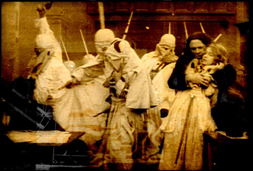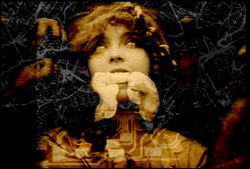The tenure of DJ Spooky (aka Paul Miller) as "that subliminal kid" has spanned a time period perhaps best defined by the accelerated way in which we have come to rely on computers and technology to relate to each other and the world around us. In his video-sound collage "ReBirth of a Nation," Spooky asks us to take a critical view of past events and attitudes, to consider history through many lenses, while hoping that in doing so we might escape Santayana's conviction that "those who do not understand the past are doomed to repeat it."

After a hypnotic storm of drum and bass combined with a blink-of-the-eye-quick reel of changing international flags and symbols (interspersed with question marks) on three large screens, the film dipped into the opening cards from DW Griffith's 1915 film The Birth of a Nation. For those unfamiliar with this work, it was the first feature-length silent film, and pioneered the "rules of grammar" film continues to follow today. "The Birth of a Nation" was also used as a Ku Klux Klan recruitment film through the 1960's and takes a Confederate view of events surrounding the Civil War.

Throbbing soundtrack notwithstanding, the first hint that this wasn't a straight playback of Griffith's original was found right on those first title cards: while the two smaller screens flanking the large one showed cards with DW's initials and surname, the larger central screen displayed cards with "Paul Miller" supplanting Griffith's markings. Whose perception of the film and events were we viewing? Even though the cards contained identical information, the change of names seemed to insinuate a change of mental venue.

Through the constant maelstrom of sound and image that, even when relatively calm, swept you ever faster through the dark heart of the film's subject matter, specific recurring images and themes served to steady the viewer and provide benchmarks. One that struck me in particular was the solitary spectral image of a dancer superimposed over and spliced into the "Birth-" footage. She would manifest, stand precipitously-- then slowly, gracefully bow, as though under the weight of the impending tragedies that always followed her appearance.
Another provocative image that would recur, overlaying interspliced samples of DW's film, was the schematic of a circuit. It would grow towards the right of the screen(s), from contact points on the left, revealing more of the diagram as its circuit-channels followed paths outward. It reminded me of the way neurons or nerve cells grow and connect to each other and tissue, and at times almost seemed viral. This image was augmented by superimposed footage of Bill T. Jones-choreographed dancers. First the circuits would flash onto the screen, notating the machinations playing out between the "Birth-" characters. Then, the dancers would spring forward under the circuits, cranking the energy level up another notch- all the while Spooky's score eddied and swirled through the whole thing. Sometimes the schematics would become more complex, illustrating the web around all of the characters and almost revealing some other sort of inner plan the viewer couldn't –quite- grasp.

The soundscape DJ Spooky produced for this work is as striking and important to the audience's experience as anything on the screens. Rebirth of a Nation's interweaving of technology, history, and the viewer's ever-present doubt of whose eyes they're actually seeing these events through is nailed by the use of sound. Heavy fisted beats ebb away into seas of distorted near-atonal noise jams, which in turn dissipate to reveal sampled string and wind instruments that would have been recognizable to the original's audiences of 1915 and Civil War contemporaries alike. Bass and cello, harmonica and some sort of flute meander and stride along with synthetic drum kit beats and digital scratch pads. Again, the bridges (and nerve connections?) between our technological and biological lives are underscored. There was one passage in particular, where the film is winding up to a climax, that the score winds up with it, a hurricane spinning tighter and tighter, seemingly gathering more mass, until Climax! The music is flung loose from the centrifugal force of the film, just as the film itself had a corresponding visual sense of release. As the sound and film seemed to give itself a moment of exhausted punctuation, I couldn't shake the feeling that "Rebirth-" had just described a total sense of inescapable entropy.

In remixing a film notable for its place in history, its content, and the way it still touches us (both in how cinematographers use film today and in the ripples its view of history still produces) Paul Miller, aka DJ Spooky, asks us to at once take a broader perspective on events and to take a closer look at how we come to our own decision making processes. An image that started the presentation could also have concluded it: As the pictures of international and regional flags (one of which hailed from Dixie) flipped by, several per second, you started to see a circled question mark blinking up every so often, then more and more often and finally towards the end of the reel almost every other flag image seemed questioned. What country, or identity, do you choose? Do you have a choice? Who determines history? What does it all mean anyway? For me, I choose to think of it like this: keep the question mark flashing, always, over everything.
Jen Rybolt is currently a rock star, a PNCA student and a guest contributor to PORT, focusing on TBA coverage.
I saw the Friday show. I've never seen the original although I've read about it many times in film and media books. I wished Rybot had given more critique to the intense content and its effect in DJ Spooky’s remix.
Griffith was skilled at creating a visual hysteria and narrative to match the hysterical racist and confederate slave ideology he used as a vehicle for his film. The climax of the film is shocking: a white damsel literally is chased of the edge of cliff by a black soldier (black-faced white actor) implicitly trying to rape her. She would rather die than attempt to defend herself. At the show in the mezzanine where I sat, several gasps were audible at the death of the damsel.
Juxtaposing in my mind the film with the images of New Orleans Katrina disaster footage was poignant. The original film encapsulates the U.S.’s racist ideologies of the past and now we can still see it still has a life: Police in Grenta, a neighbor of New Orleans, stopped the people, that is non-whites, from evacuating through their city for fear of looting Grenta.
Without the serendipitous New Orleans disaster juxtaposition I think my remix impression would have been lessened. The music is essential in reworking the film and Spooky makes an excellent soundtrack. In Spooky’s introduction, which was necessary context, he notes this was the first film to be shown in the White House. He then joked, "I think Bush and Condi are still watching it..." I laughed, many others did too, and a few actually booed!
What the intro also defined was a critical position against what the film stands for. This is necessary because by the end of the remix I realized that if I didn’t know Spooky's context, my own context, the performance context, I could just as fittingly be walking out of modern Klu Klux Klan meeting. Spooky notes the original was used as a KKK recruitment tool through the 1950’s.
I think the remix allows new viewers like myself to understand that this powerful and disturbing film is worth framing in contemporary terms.



























![[TypeKey Profile Page]](http://www.portlandart.net/nav-commenters.gif)